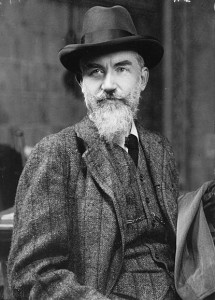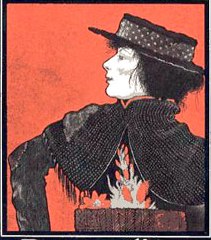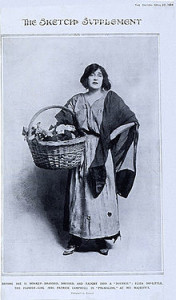My Fair Lady: The Myth, The Play, The Musical (Part 2)
Part 2 – The Play
As we learned in last week’s blog, in ancient Greek mythology, Pygmalion fell in love with one of his sculptures, which then came to life. The general idea of that myth was actually quite a popular subject for Victorian era English playwrights. In fact, one of Shaw’s influences, W.S. Gilbert, wrote a rather successful play based on the story called Pygmalion and Galatea. This blank verse play, which was presented in three acts, premiered at the Haymarket Theatre in London on December 9, 1871 and ran for a very successful 184 performances. Gilbert’s Pygmalion was so popular that other versions of the play were rushed to the stage, including Ganymede and Galatea in January of 1872, William Brough’s Pygmalion; or, The Statue Fair in March of 1872, and in May of that same year a visiting French company produced VictorMassé’s Galathée. And not too long after in 1883, Galatea, or Pygmalion Re-Versed, a musical burlesque that parodies the Pygmalion myth and specifically Gilbert’s 1871 play, premiered at the Gaiety Theatre in London.

George Bernard Shaw’s Pygmalion, however, is easily the most well-known stage play of any similar title. It both delighted and scandalized its first audiences in 1914. A brilliantly witty reworking of the Ovid tale of a sculptor who falls in love with his perfect female statue, it is also a barbed attack on the British class system and a statement of Shaw’s feminist views. In Shaw’s hands, the phoneticist Henry Higgins is the Pygmalion figure who believes he can transform Eliza Doolittle, a cockney flower girl, into a duchess at ease in polite society. The one thing he overlooks is that his ‘creation’ has a mind of her own. Pygmalion nevertheless probes important questions about social class, human behavior, and relations between the sexes.

Hoping to circumvent what he felt was the tendency of the London press to criticize his plays unfairly, Shaw chose to produce a German translation of Pygmalion in Vienna and Berlin before bringing the play to London. The London critics appreciated the acclaim the play had received overseas, and, after it opened at His Majesty’s Theatre on April 11, 1914, it enjoyed success, firmly establishing Shaw’s reputation as a popular playwright.
The popularity of the play caused its leap from stage to screen. Shaw was always reluctant to have his plays filmed because he would not tolerate any tampering with his dialogue, but he was persuaded by Gabriel Pascal to allow a film version of Pygmalion. Writing the screenplay for the film version of 1938 helped Shaw to become the first and only man ever to win both the Nobel Prize for literature and an Academy Award.

However, concessions were extracted from Shaw by the film’s producers, who changed the ending and watered down some of the supporting characters. Before the film came out, Shaw in fact wrote a ‘sequel’ to his first publication of the play. This was to solidify his ending and rebut any possible public demand for a more conventionally romantic ending.
Check back next week to learn how this play turned into one of the most popular musicals of all time.